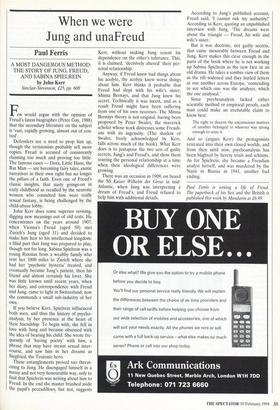When we were Jung and unaFreud
Paul Ferris
A MOST DANGEROUS METHOD: THE STORY OF JUNG, FREUD, AND SABINA SPIELREIN by John Kerr
Sinclair-Stevenson, f25, pp. 608
Few would argue with the opinion of Freud's latest biographer (Peter Gay, 1988) that the secondary literature on the subject is 'vast, rapidly growing, almost out of con- trol'.
Defenders see a need to prop him up, though the revisionists probably sell more copies. Freud is accused of consistently claiming too much and proving too little. The famous cases — Dora, Little Hans, the Rat Man — are becoming fairy tales, exotic narratives in their own right but no longer the pillars of a faith. Even one of Freud's classic insights, that nasty goings-on in early childhood as recalled by the neurotic women who consulted him were really sexual fantasy, is being challenged by the child-abuse lobby.
John Kerr does some superior revising, digging new meanings out of old texts. He concentrates on the years around 1907, when Vienna's Freud (aged 50) met Zurich's Jung (aged 31) and decided to make him heir to his intellectual kingdom: a filial part that Jung was prepared to play, though not for long. Sabina Spielrein was a young Russian from a wealthy family who sent her 1000 miles to Zurich where she had her 'psychotic hysteria' treated, and eventually became Jung's patient, then his friend and almost certainly his lover. She was little known until recent years, when her diary, and correspondence with Freud and Jung, came to light in Switzerland; now she commands a small sub-industry of her own.
If you believe Kerr, Spielrein influenced both men, and thus the history of psycho- analysis, by her presence at the heart of their friendship. To begin with, she fell in love with Jung and became obsessed with the idea of bearing his child. She wrote fre- quently of 'having poetry' with him, a Phrase that may have meant sexual inter- course, and saw him in her dreams as Siegfried, the Teutonic hero.
These entanglements proved too threat- ening to Jung. He disengaged himself in a messy and not very honourable way, only to find that Spielrein was writing about him to Freud. In the end the master brushed aside the pupil's peccadilloes, but not, suggests
Kerr, without making Jung resent his dependence on the other's tolerance. This, it is claimed, 'decisively altered' their per- sonal relationship.
Anyway, if Freud knew bad things about his acolyte, the acolyte knew worse things about him. Kerr thinks it probable that Freud had slept with his wife's sister, Minna Bernays, and that Jung knew his secret. Technically it was incest, and as a result Freud might have been suffering from one of his own neuroses. The Minna Bernays theory is not original, having been proposed by Peter Swales, the maverick scholar whose work distresses some Freudi- ans with its ingenuity. (The shadow of Swales, freely acknowledged by Kerr, falls across much of the book). What Kerr does is to juxtapose the two sets of guilty secrets, Jung's and Freud's, and show them souring the personal relationship at a time when their ideological differences were growing.
There was an occasion in 1909, on board the SS Kaiser Wilhelm der Gross in mid- Atlantic, when Jung was interpreting a dream of Freud's, and Freud refused to help him with additional details. According to Jung's published account, Freud said, 'I cannot risk my authority!' According to Kerr, quoting an unpublished interview with Jung, The dreams were about the triangle — Freud, his wife and wife's sister.'
But it was doctrine, not guilty secrets, that came inexorably between Freud and Jung. Kerr makes this clear enough in the parts of the book where he is not working up Sabina Spielrein as the new face in an old drama. He takes a sombre view of them as the rift widened and they hurled letters at one another across Europe, 'contending to see which one was the analyser, which the one analysed.'
Since psychoanalysis lacked either scientific method or empirical proofs, each man could make an irrefutable claim to know best:
The right to discern the unconscious motives of another belonged to whoever was strong enough to seize it.
And so (argues Kerr) the protagonists retreated into their own closed worlds, and from then until now, psychoanalysis has been blighted by heresy trials and schisms. As for Spielrein, she became a Freudian analyst herself, and was murdered by the Nazis in Russia in 1941, another bad ending.
Paul Ferris is writing a life of Freud. The paperback of his Sex' and the British is published this week by Mandarin at f6.99.


















































 Previous page
Previous page